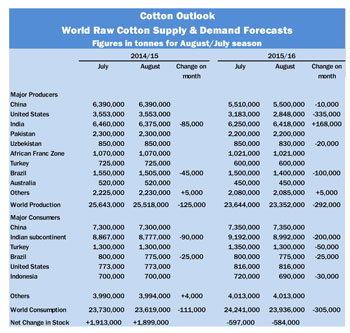France — August 25, 2015 – CEMATEX, the European Committee of Textile Machinery Manufacturers, is pleased to announce that six finalists have been shortlisted from some 30 entries for its first ITMA Sustainable Innovation Award. Three of the finalists are vying for the ITMA Industry Excellence Award while the remaining three are competing for the ITMA Research & Innovation (R&I) Excellence Award.
Industry Excellence Award
The Award recognises textile and garment manufacturers who have leveraged on technological innovations to advance business sustainability that benefit people, planet and profit. After much deliberation, the judges have picked the following three finalists who have worked closely with ITMA 2015 exhibitors to introduce innovative solutions to their production process or products:
Berto Industria Tessile S.r.l., Italy
Berto Industria Tessile, a leading vertically integrated manufacturer of denim products, was quick to recognise the economic and ecological advantages of the Matex® Eco Applicator range by ITMA exhibitor Monforts. They were the pioneer in adopting Monforts’ innovative technology, which enabled them to significantly reduce the amount of liquid needed in finishing denim fabrics, leading to energy savings and a huge reduction in waste water produced.
Gebrüder Otto GmbH & Co. KG, Germany
Gebrüder Otto, one of the leading yarn manufacturers in Europe, implemented Mayer & Cie.’s spinitsystems® to produce single jersey fabric using up to 35 per cent less energy compared to the conventional process. As a spinning mill, Gebrüder Otto produces the roving bobbins which are processed on the Spinit machines.
Levi Strauss & Co., United States
Levi Strauss & Co., one of the world’s largest brand name apparel companies and a global leader in jeanswear, has started preliminary development work in their Plock facility in Poland using the NoStone® garment washing technology. Tonello’s NoStone technology provides Levi Strauss & Co. an important first step to solving an industry challenge to make denim finishing more sustainable, cost-effective and efficient.
Mr Charles Beauduin, who sits on the Industry Excellence Award judging panel and is also President of CEMATEX, said: “We thank ITMA 2015 exhibitors for supporting this award. What differentiates this award from other industry recognition is that we celebrate the successful collaboration between technology providers and industry users, which ultimately benefits consumers.
“Necessity is the mother of invention, and the synergies from both parties working together towards a common goal will bring about more innovative solutions that will positively impact the environment and the business bottom line.”
R&I Excellence Award – Masters
The three finalists for the award are:
-
Jan Vincent Jordan, Institut Für Textiltechnik, RWTH Aachen University — Master’s Thesis: ‘Development & Assembly of a Test Bench for the Analysis of Magnetic Weft Insertion’
-
Jenifer Schneidereit, Hochschule Niederrhein — Master’s Thesis: ‘Sustainable Water Use in Textile Wet Processing: Development of a List of Improvement Measures for a Self-Assessment Tool for Factories’
-
Moniruddoza Ashir, Institute of Textile Machinery and High Performance Material Technology, TU Dresden — Master’s Thesis: ‘Development of Hybrid Woven Structures for Lightweight Applications’
The winners of the ITMA Sustainable Innovation Award will be announced at the ITMA 2015 Gala Dinner held at the La Pelota in Milan on November 12. The winner of the Industry Excellence Award will receive a cash prize of 10,000 euros and a trophy, among other rewards. A cash prize of 4,000 euros will be given to the winner of the R&I Excellence Award.
CEMATEX has launched ITMA Sustainable Innovation Award as part of its ongoing efforts to encourage and recognise outstanding industry members and post-graduate students for their contributions to the sustainable development of the global textile and garment industry.
ITMA 2015 will be held at the Fiera Milano Rho November 12-19, 2015. It showcases end-to-end solutions for the entire textile and garment making chain. The exhibition has a gross size of over 200,000 square metres. To date, more than 1,500 exhibitors from 47 economies have signed up to take part in the exhibition. Visitors can purchase their ITMA 2015 badge online before October 15, 2015 to enjoy early-bird rates.
Posted August 25, 2015
Source: ITMA





